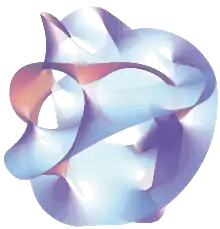N = 4 supersymmetric Yang–Mills theory
N = 4 supersymmetric Yang–Mills (SYM) theory is a mathematical and physical model created to study particles through a simple system, similar to string theory, with conformal symmetry. It is a simplified toy theory based on Yang–Mills theory that does not describe the real world, but is useful because it can act as a proving ground for approaches for attacking problems in more complex theories.[1] It describes a universe containing boson fields and fermion fields which are related by 4 supersymmetries (this means that swapping boson, fermion and scalar fields in a certain way leaves the predictions of the theory invariant). It is one of the simplest (because it has no free parameters except for the gauge group) and one of the few finite quantum field theories in 4 dimensions. It can be thought of as the most symmetric field theory that does not involve gravity.
| String theory |
|---|
 |
| Fundamental objects |
| Perturbative theory |
| Non-perturbative results |
| Phenomenology |
| Mathematics |
Lagrangian
The Lagrangian for the theory is[2]
where and indices i,j = 1, ..., 6 as well as a, b = 1, ..., 4. represents the structure constants of the particular gauge group. represents the structure constants of the R-symmetry group SU(4), which rotates the 4 supersymmetries. As a consequence of the nonrenormalization theorems, this supersymmetric field theory is in fact a superconformal field theory.
Ten-dimensional Lagrangian
The above Lagrangian can be found by beginning with the simpler ten-dimensional Lagrangian
where I and J are now run from 0 through 9 and are the 32 by 32 gamma matrices , followed by adding the term with which is a topological term.
The components of the gauge field for i = 4 to 9 become scalars upon eliminating the extra dimensions. This also gives an interpretation of the SO(6) R-symmetry as rotations in the extra compact dimensions.
By compactification on a T6, all the supercharges are preserved, giving N = 4 in the 4-dimensional theory.
A Type IIB string theory interpretation of the theory is the worldvolume theory of a stack of D3-branes.
S-duality
The coupling constants and naturally pair together in the form:
The theory has symmetries that shift by integers. The S-duality conjecture says there is also a symmetry which sends : as well as switching the group to its Langlands dual group.
AdS/CFT correspondence
This theory is important also in the context of the holographic principle. There is a duality between Type IIB string theory on AdS5 × S5 space (a product of 5-dimensional AdS space with a 5-dimensional sphere) and N = 4 super Yang–Mills on the 4-dimensional boundary of AdS5. However, this particular realization of the AdS/CFT correspondence is not a realistic model of gravity, since gravity in our universe is 4-dimensional. Despite this, the AdS/CFT correspondence is the most successful realization of the holographic principle, a speculative idea about quantum gravity originally proposed by Gerard 't Hooft, who was expanding on work on black hole thermodynamics, and was improved and promoted in the context of string theory by Leonard Susskind.
Integrability
There is evidence that N = 4 supersymmetric Yang–Mills theory has an integrable structure in the planar large N limit.[3] As the number of colors (also denoted N) goes to infinity, the amplitudes scale like , so that only the genus 0 (planar graph) contribution survives. Planar Yang–Mills theory is a theory with a very large (infinite) number of colors.
A planar limit is a limit in which scattering amplitudes are dominated by Feynman diagrams which can be given the structure of planar graphs.[4]
Beisert et al. give a review article demonstrating how in this situation local operators can be expressed via certain states in "spin" chains, but based on a larger Lie superalgebras rather than SU(2) for ordinary spin. These are amenable to Bethe ansatz techniques. They also construct an action of the associated Yangian on scattering amplitudes.[5]
Nima Arkani-Hamed et al. have also researched this subject. Using twistor theory, they find a description (the amplituhedron formalism) in terms of the positive Grassmannian.[6]
Relation to 11-dimensional M-theory
N = 4 super Yang–Mills can be derived from a simpler 10-dimensional theory, and yet supergravity and M-theory exist in 11 dimensions. The connection is that if the gauge group U(N) of SYM becomes infinite as it becomes equivalent to an 11-dimensional theory known as matrix theory.
References
Citations
- Matt von Hippel (2013-05-21). "Earning a PhD by studying a theory that we know is wrong". Ars Technica.
- Luke Wassink (2009). "N = 4 Super Yang–Mills theory" (PDF). Archived from the original (PDF) on 2014-05-31. Retrieved 2013-05-22.
- Martin Ammon, Johanna Erdmenger, Gauge/Gravity Duality: Foundations and Applications, Cambridge University Press, 2015, p. 240.
- planar limit in nLab
- Beisert, Niklas (January 2012). "Review of AdS/CFT Integrability: An Overview". Letters in Mathematical Physics. 99: 425. arXiv:1012.4000. Bibcode:2012LMaPh..99..425K. doi:10.1007/s11005-011-0516-7.
- Nima Arkani-Hamed; Bourjaily, Jacob L.; Freddy Cachazo; Goncharov, Alexander B.; Alexander Postnikov; Jaroslav Trnka (2012). "Scattering Amplitudes and the Positive Grassmannian". arXiv:1212.5605 [hep-th].
Sources
- Kapustin, Anton; Witten, Edward (2007). "Electric-magnetic duality and the geometric Langlands program". Communications in Number Theory and Physics. 1 (1): 1–236. arXiv:hep-th/0604151. Bibcode:2007CNTP....1....1K. doi:10.4310/cntp.2007.v1.n1.a1.